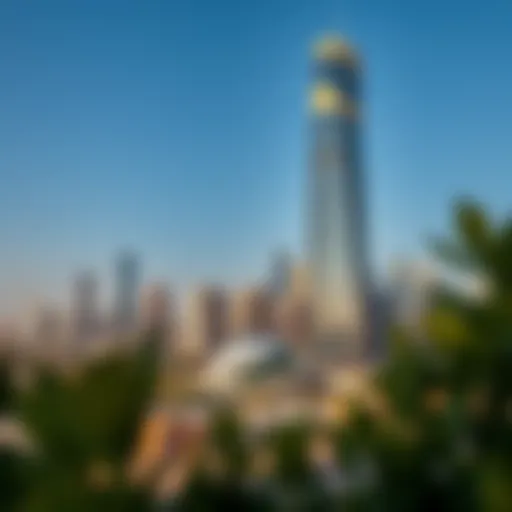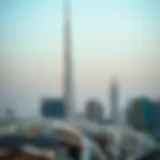Exploring Outdoor Spaces: Dynamics of Dubai's Real Estate


Intro
As Dubai continues to rise as a cosmopolitan hub, the role of outdoor spaces has increasingly taken center stage in the city's real estate landscape. The skyline, with its towering structures, offers a stark contrast to the serene and meticulously designed external environments that provide residents and investors alike a much-needed breath of fresh air amidst the hustle and bustle of urban life. Understanding the dynamics of these outdoor spaces is essential for anyone involved in the property market, be it homeowners, developers, or potential buyers.
This article dives into the significant evolution of outdoor spaces within Dubai's real estate framework, revealing how these elements not only serve aesthetic purposes but also constitute crucial extensions of living areas. Herein, we will explore the trends shaping outdoor design, practical applications that enhance usability, and cultural influences that mold the perception of these outdoor sectors. Let’s explore how thoughtful integration of nature and architecture can elevate the quality of life in this vibrant city.
Significance of Outdoor Spaces
Outdoor spaces play a pivotal role in enhancing the quality of life, particularly in urban landscapes like Dubai. These spaces offer much more than just a sunny escape—they're integral to community interaction, individual well-being, and even local economies. As society increasingly recognizes the direct correlation between environment and lifestyle, outdoor areas have transformed into essential elements for residences and commercial properties alike.
Enhancing Lifestyle
When considering the lifestyle in a vibrant city like Dubai, outdoor spaces offer a necessary reprieve from the fast-paced urban life. They facilitate various activities that contribute positively to physical and mental health. Parks, gardens, and outdoor cafes promote social gatherings and physical activities, fostering a sense of community. The presence of greenery also plays a significant role in mental well-being, providing a tranquil setting for relaxation and retreat.
- Boosting Personal Health: Engaging in outdoor activities such as jogging, walking, or even casual lounging contributes to one's overall health and well-being, often leading to increased happiness and productivity.
- Social Connectivity: Outdoor spaces serve as melting pots where individuals from diverse backgrounds can interact, share experiences, and forge new relationships, ultimately enriching the community fabric.
- Economic Benefits: Properties with readily accessible outdoor areas often see a rise in demand. Such amenities can elevate the property’s perceived value, making it appealing to potential buyers and investors alike.
For these reasons, the integration of thoughtfully designed outdoor spaces should be seen not merely as an aesthetic enhancement but rather as a fundamental aspect of urban planning that enriches lifestyle.
Cultural Context of Outdoor Living in Dubai
Understanding the cultural context of outdoor living in Dubai adds another layer of complexity to appreciating its outdoor spaces. The lifestyle in this city is a harmonious blend of tradition and modernity, where outdoor areas are embraced for shared experiences and communal gatherings.
Traditionally, the emirate has a long history of outdoor enjoyment influenced by its desert surroundings and social customs. Outdoor areas serve as venues for cultural events, family gatherings, and festive celebrations, reinforcing community ties.
- Adaptation to Climate: While Dubai's hot climate poses challenges, innovative architectural designs and shaded areas have allowed outdoor spaces to flourish. Developers and city planners are increasingly conscious of creating environments that can be utilized year-round.
- Cultural Celebrations: Events such as Ramadan often see families breaking their fast outdoors. Festivals and exhibitions are commonly held in parks, showcasing the rich cultural heritage through art and performances.
- Diverse Recreational Options: Various recreational facilities, from playgrounds to sports courts, cater to the wide-ranging tastes of Dubai's residents, symbolizing its cosmopolitan nature.
In a nutshell, the significance of outdoor spaces in Dubai reflects the city's commitment to fostering a vibrant lifestyle while honoring its cultural roots. The success of these spaces lies in their ability to adapt, evolve, and serve the needs of an ever-changing population.
Design Considerations
Design considerations play a vital role in shaping outdoor spaces, especially in a dynamic city like Dubai. The integration of functional and aesthetic elements can significantly enhance the usability and appeal of these areas. These considerations focus on how to harmonize outdoor environments with architectural features, ensure sustainability, and create comfortable spaces for a diverse user base. An awareness of these design facets is essential for anyone involved in the development of real estate or public spaces.
Integration with Architecture
The seamless integration of outdoor spaces with existing architecture establishes a coherent narrative that resonates with the urban fabric of Dubai. This integration goes beyond mere aesthetics; it involves thoughtful placement and design that encourages movement between indoor and outdoor areas. Considerations such as materials, colors, and forms all contribute to a more inviting atmosphere. Effective design may incorporate architectural elements like large windows and balconies, which enhance visual connections between spaces. This not only allows for natural light to spill into interiors but also encourages the use of outdoor spaces throughout the day.
Environmental Sustainability
Environmental sustainability has gained paramount importance in urban planning, particularly in a rapidly growing metropolis. Sustainable design practices enable the city to mitigate environmental impacts while fostering natural habitats. By placing emphasis on native flora and intelligent water management, developers can create green spaces that are both environmentally sound and visually appealing.
Use of Native Plants
Using native plants in landscaping is more than just a trend; it reflects a commitment to creating environmentally sustainable outdoor spaces. Native plants are adapted to the local climate and biodiversity, making them resilient and low-maintenance options. Their ability to thrive without excessive watering or fertilizers significantly reduces the environmental footprint of landscaping. For Dubai, where water is a precious resource, relying on these plants means conserving water while adding vibrant colors and textures to outdoor spaces. However, a challenge is the initial perception that native plants aren’t aesthetically pleasing. Properly designed landscapes can showcase their beauty, challenging this misconception.
Water Management Strategies
Effective water management strategies are critical in ensuring that outdoor spaces flourish in Dubai's arid climate. Techniques such as rainwater harvesting, permeable pavements, and irrigation systems powered by smart technology can significantly reduce water wastage. Implementing these water management strategies not only supports the lush aesthetics of outdoor areas but also ensures the long-term viability of the plants used in landscaping. However, the upfront investment may deter some developers; balancing costs with potential future savings is vital for widespread acceptance.
Comfort and Usability


Creating outdoor spaces that prioritize comfort and usability is essential for enticing both residents and visitors to spend time in these areas. This means selecting materials and design strategies that promote durability and accessibility, contributing to a positive user experience.
Selecting Materials
The choice of materials used in outdoor spaces can dramatically influence both their functionality and appeal. Utilizing weather-resistant materials ensures that outdoor environments can withstand the harsh conditions of the Dubai climate. Additionally, materials should enhance the tactile experience, inviting users to engage with their surroundings. While some may opt for traditional stone or concrete, there’s a growing trend towards eco-friendly alternatives like recycled composites or sustainable wood, which could be both appealing and respectful to the environment. Each choice, however, comes with trade-offs, such as cost and availability, that must be weighed carefully.
Climate Adaptation Strategies
Implementing climate adaptation strategies is crucial for maximizing the usability of outdoor spaces regardless of seasonal variations. This may involve creating shaded areas through thoughtful placement of trees or pergolas, as well as using reflective materials to minimize heat absorption. In addition, windbreaks can be designed strategically to provide relief during hot, windy days. However, these adaptations must be tailored carefully; misjudging local climate nuances could lead to the creation of spaces that are either too stuffy in the summer or too exposed in the winter. The ultimate goal should be achieving a balance that maintains comfort throughout the year.
By acknowledging these key design considerations, developers and stakeholders can not only create functional outdoor spaces but also enhance the overall quality of life in Dubai, making outdoor spaces both practical and enjoyable for all.
Trends in Outdoor Spaces
The landscape of outdoor spaces has seen significant changes recently, especially in vibrant cities like Dubai. As the city continues to evolve, trends in outdoor spaces become increasingly crucial for improving the community's quality of life and attracting potential investors. It's not merely about aesthetics anymore; functional outdoor spaces can uplift property values and enhance lifestyle. With the current rise in outdoor amenities, understanding these dynamics is essential for anyone involved in real estate, from investors to homeowners.
Increase in Outdoor Amenities
Gone are the days when a balcony or a garden was just a nice-to-have. Today, outdoor amenities have become a determining factor in property purchases. Amenities like outdoor lounges, parks with walking trails, and communal gardens are becoming standard in new developments. Why the shift? Simply put, people crave outdoor experiences, especially in a city known for its distinct climate and luxurious lifestyle.
- Enhanced Social Interactions: Outdoor spaces allow residents to connect, fostering a sense of community. Families and friends gather to barbeque or simply soak up the sun in shared green spaces.
- Health Benefits: With more people becoming conscious of their health, having access to outdoor spaces encourages physical activities like jogging or yoga. It merges fitness with leisure seamlessly, especially considering Dubai's appeal as a cosmopolitan hub.
- Work-Life Balance: A rise in outdoor amenities also speaks to the increased emphasis on work-life balance. Having spaces designed for relaxation or informal meetings boosts productivity and well-being.
"Outdoor amenities are not just a luxury anymore; they are a necessity in today's fast-paced world. They represent a lifestyle choice that today's buyers are willing to invest in."
Outdoor Workspaces
As more people work remotely or engage in flexible work arrangements, outdoor workspaces are a trend gaining traction. Picture this: lush rooftop gardens equipped with Wi-Fi, comfortable seating, and shaded areas for those blistering hot days. This provides an alternative to the usual office environment, allowing individuals to blend work with nature.
- Boosting Creativity: Studies have shown that nature can enhance creativity and reduce stress levels. Working in an outdoor setting often leads to fresh thinking and improved mood.
- Flexible Arrangements: For developers, incorporating outdoor workspaces into their design can differentiate them in a competitive market. It attracts a demographic keen on modern solutions that cater to their lifestyle needs.
- Integration with Nature: By creating workspaces surrounded by greenery, developers can offer a unique experience that resonates with nature lovers while enhancing the aesthetic appeal of their properties.
Adapting to these trends not only improves the resident experience but can also yield lucrative returns for investors. As the outdoor ambiance continues to play an increasingly pivotal role in property development, understanding and implementing these trends could make a world of difference in the ever-competitive Dubai market.
Regulatory Aspects
Understanding the regulatory framework surrounding outdoor spaces in Dubai is essential for various stakeholders, including investors, realtors, and developers. Regulations can have a significant impact on how outdoor amenities are designed, constructed, and maintained. Ignoring these legal requirements can lead to hefty fines or even the demolition of non-compliant structures. Moreover, being knowledgeable about zoning regulations and building codes fosters a smoother development process and enhances the potential value of real estate investments.
Zoning Regulations Impacting Outdoor Spaces
Zoning regulations dictate how land can be used in a specific area. In Dubai, these rules play a fundamental role in shaping outdoor spaces, impacting dimensions, types of installations, and even landscaping choices. For instance, if a residential area is designated as a mixed-use space, developers may have more freedom to include amenities like cafes, parks, or recreational areas.
It’s crucial for developers to consult with local authorities to understand the specifics of the zoning laws applicable to their projects. By doing this, they can design outdoor spaces that not only comply with regulations but also cater to community needs.
- Setbacks: Required distances between buildings and property lines often dictate how much space can be utilized for outdoor features.
- Density Restrictions: Planners must adhere to the maximum number of occupants in a given area, which can affect the type of outdoor environments created.
- Land Use Types: Regulations specify what types of outdoor spaces (e.g., parks, plazas) are permissible within certain zoning classifications.
Ensuring compliance with zoning regulations maximizes utility while minimizing potential disputes down the line.
Building Codes and Compliance
Building codes serve as a guide to ensuring safety, accessibility, and utility in the construction of outdoor spaces. In Dubai, these codes include stipulations regarding materials, load requirements, and safety features. Such codes are established not just for aesthetics but to ensure that outdoor areas can withstand the environmental challenges of the region, including extreme heat and occasional heavy rains.


- Material Standards: Outdoor spaces often require specific materials that are durable and weather-resistant. Using materials that comply with these standards can avoid costly repairs in the long run.
- Accessibility Guidelines: Regulations may outline requirements for accessibility, ensuring that outdoor spaces can be enjoyed by all members of the community, including those with disabilities.
- Safety Regulations: There often need to be safety measures in place for structures such as canopies, awnings, or playground equipment to protect users.
"Adhering to building codes not only ensures regulatory compliance but also enhances the trustworthiness of developments among potential buyers."
In summary, a deep understanding of zoning regulations and building codes is pivotal for anyone involved in Dubai's real estate market. Both aspects ensure not just the legal viability of outdoor spaces but also their functional appeal, directly impacting property values and community satisfaction.
Impact on Real Estate Value
The influence of outdoor spaces on real estate value in Dubai is more than just a trend; it represents a significant cornerstone for homeowners, developers, and investors alike. As the market continues to evolve, the outdoor elements incorporated into properties play a crucial role in their overall appeal—impacting not only their immediate value but also their long-term investment potential.
Perceived Value of Outdoor Features
Outdoor features, such as landscaped gardens, rooftop terraces, and well-designed communal areas, have become integral to property assessments. Buyers increasingly view these amenities not merely as aesthetic advantages, but as essential components of modern living. A home that offers a private garden or a spacious balcony tends to attract a premium price compared to those that lack such features.
Factors that shape the perceived value include:
- Functionality: Practical use of outdoor spaces encourages social interaction, relaxation, and leisure activities. These factors help enhance the livability of a property, making it more attractive to potential buyers.
- Aesthetics: Visually pleasing outdoor environments can enhance curb appeal, allowing properties to stand out in competitive markets.
- Health and Well-being: Outdoor features are associated with better quality of life. Access to green spaces is linked to reduced stress and healthier lifestyles, making such properties more desirable.
"Real estate investors should recognize that the inclusion of well-thought-out outdoor spaces can be a game changer in property valuation, especially in a dynamic market like Dubai."
Market Trends and Outdoor Spaces
The landscape of outdoor spaces is changing, adapting to modern needs and preferences. Current market trends suggest that the demand for properties with strong outdoor features is on the rise. Here are a few notable trends worth mentioning:
- Emphasis on Sustainable Design: Buyers are looking for environmentally friendly features. Properties that integrate sustainable outdoor elements—like native plant gardens or solar-powered lighting—tend to attract higher interest.
- Community-Oriented Spaces: As more people seek a sense of community, developers are focusing on creating shared outdoor environments that encourage interaction among residents. Markets are seeing an increase in communal gardens and open spaces designed for gatherings.
- Flexible Outdoor Areas: The traditional notion of an outdoor space is evolving. Increasingly, buyers desire flexible outdoor areas that can serve multiple purposes, such as hosting events or serving as home offices.
User Experience and Feedback
In the realm of outdoor spaces, user experience and feedback play a crucial role, especially in a fast-evolving city like Dubai. Understanding what users think about outdoor amenities provides valuable insights that can guide developers, investors, and city planners. The satisfaction of those using these spaces speaks volumes about their design and functionality. If people find joy and utility in outdoor areas, it reflects positively not only on individual properties but on the wider community as well.
Satisfaction with Outdoor Amenities
Satisfaction with outdoor amenities is not merely a matter of preferences; it is deeply entwined with how these spaces are perceived and utilized. For instance, lush parks equipped with benches, jogging tracks, and children's play areas often receive rave reviews from families. Likewise, cozy cafés with outdoor seating can serve as a social hub, drawing in crowds who appreciate being in touch with nature while enjoying their coffee.
To assess satisfaction comprehensively, it’s essential to consider various factors:
- Accessibility: How easy is it for individuals to reach these spaces? Barriers might discourage use, while well-placed pathways invite people in.
- Versatility: Do the amenities serve multiple functions? A space that can host events, serve as a play area, or simply offer a place to unwind scores high on satisfaction.
- Aesthetic Appeal: The visual experience cannot be overlooked. Well-designed gardens and attractive structures enhance enjoyment.
- Safety and Comfort: Adequate lighting, seating, and shade are essential. Safety features create an environment where people feel secure.
These elements transcend individual preference and influence broader community well-being. When residents express satisfaction, it can lead to an increased sense of belonging and community pride.
Gathering Feedback for Improvements
Collecting feedback is an important next step in the continuous enhancement of outdoor spaces. After all, what better way to fulfill the needs of residents than to ask them directly? Gathering feedback involves different methodologies, and utilizing a mix can offer a comprehensive view.
- Surveys and Questionnaires: Simple surveys can provide quantifiable data about user satisfaction. Questions can range from direct queries about amenities' cleanliness to open-ended ones asking for suggestions for improvement.
- Community Meetings: Getting locals together fosters dialogue. These gatherings can lead to lively discussions, allowing participants to share their experiences and aspirations for the space.
- Social Media Engagement: Platforms like Facebook and Reddit can be effective for gauging public sentiment. Posts that invite comments on particular outdoor areas often yield valuable insights.
- Observation and User Tracking: Sometimes, simply observing how people use a space can reveal patterns that aren’t obvious through surveys. This can also highlight peak usage times and the types of activities that are most popular.
In the end, the information collected can lead to substantive changes in the designs of outdoor spaces or additional features that can enhance usability. It aligns development with the community’s real needs, fostering a sense of ownership.
Feedback isn’t just about improving a space; it’s about building a relationship with the community. The more involved the locals feel, the more vibrant and cherished the outdoor spaces will become.


Future of Outdoor Spaces in Dubai
The future of outdoor spaces in Dubai is not just a matter of aesthetics; it is intertwined with lifestyle, urban planning, and environmental stewardship. As the city continues to grow and evolve, there is an increasing recognition of the crucial role that outdoor environments play in enhancing public well-being and community interaction. The integration of nature in urban settings supports health, social connectivity, and even local economies, making it a matter of importance not only for residents but also for investors and developers who are looking at long-term gains.
Innovation in Outdoor Design
When discussing innovation in outdoor design, the focus shifts toward how creative solutions are being applied to respond to the specific challenges that Dubai faces. Designers are now adopting more flexible outdoor arrangements, allowing settings to serve various purposes throughout the day.
- Multifunctional Spaces: Parks and plazas are no longer single-purpose. They are now designed to accommodate various events, from farmer's markets to public art installations, catering to the diversity of the community.
- Smart Technology: The inclusion of smart technologies—such as interactive water features that respond to weather conditions or sustainable cooling systems—ensures that outdoor spaces remain usable, comfortable, and efficient. This tech infusion helps in managing resources while also engaging users.
- Art and Culture: Art installations that reflect local heritage and culture are becoming more prominent. These features not only beautify the space but also act as landmarks that foster a sense of belonging among residents and visitors alike.
Such innovations signal a shift towards designing outdoor spaces that emphasize personal experiences, community values, and environmental considerations—all of which resonate well with the sophisticated audience looking for quality and meaning.
Adapting to Climatic Changes
Dubai's climate poses unique hurdles for outdoor design, given the extreme heat and less predictable weather patterns observed in recent years. Addressing these climatic changes isn’t just vital; it’s imperative for ensuring the functionality of outdoor environments.
- Shade Structures and Green Roofing: Utilizing shade structures and integrating green roofing systems allows for outdoor areas to be used comfortably even during peak temperatures. These structures not only provide respite from the sun but also help maintain cooler ground temperatures, which can significantly enhance user experience.
- Efficient Water Management: Managing water supply creatively—for example, employing drought-resistant landscaping—becomes critical amid seasonal fluctuations. Such strategies promote sustainability and decrease long-term operational costs, making them appealing to investors and developers.
- Natural Ventilation and Microclimates: Creating microclimates with thoughtful plant placements and water features can reduce ambient temperatures. These can provide oasis-like environments within the city, making them desirable spots for both leisure and work.
In summary, recognizing these climatic shifts will be essential for ensuring that outdoor spaces remain attractive and functional. This ongoing adaptation not only serves immediate community needs but also contributes to broader sustainability initiatives that resonate with investors and stakeholders.
The evolution of outdoor spaces in Dubai reflects a concerted effort to harmonize human life with nature, setting a standard that other metropolitan areas may look toward in future urban planning initiatives.
For further reading, here are some insightful resources:
All of these elements converge to underscore the significant impact that thoughtful design can have on the future of Dubai's outdoor environments.
Comparative Analysis
The comparative analysis of outdoor spaces plays a crucial role in understanding how Dubai's offerings align with global standards and trends. It allows us to make sense of unique local practices, exploring what works in Dubai and what is influenced by international standards. The importance of this analysis lies in its ability to help investors, developers, and policymakers grasp the evolving dynamics of outdoor environments.
Dubai vs. Global Trends
Case Studies from Major Cities
When examining case studies from major cities worldwide, the differences in outdoor space utilization become strikingly clear. For example, in cities like Paris, outdoor cafes are a staple of public life, serving more than just coffee; they act as vital social hubs where community bonds strengthen. This aspect of urban design shows how outdoor spaces can promote social interaction and is a characteristic valued in an outdoor-centric environment.
Furthermore, places like New York have embraced the concept of ‘green roofs’ and urban parks, providing much-needed greenery amid concrete jungles. This merging of nature within a cityscape mirrors the interests in Dubai for sustainable outdoor spaces. Thus, understanding these studies allows for cross-pollination of ideas that can lead to innovative solutions tailored for Dubai's unique challenges, such as its harsh climate.
Some key characteristics of successful outdoor spaces from these case studies include:
- Accessibility: Ensuring outdoor spaces are easy to reach and use for everyone.
- Amenities: Providing features like water fountains, shade structures, and seating.
- Aesthetic Appeal: Creating visually attractive environments that entice residents and tourists alike.
- Community Focus: Spaces that encourage gatherings or events tend to boost local engagement.
However, while Dubai has its unique charm, it must carefully consider these aspects to avoid overcrowding and ensure sustainability. The draw of vibrant outdoor spaces can often lead to their overuse, which may detract from the experience if not managed well.
Unique Features of Dubai's Outdoor Spaces
Dubai's outdoor spaces are distinguished by several unique traits that cater specifically to its environment and culture. One of the most significant features is the emphasis on luxury and comfort. From lavishly designed beachfronts to lush parks with state-of-the-art facilities, the city embodies a level of outdoor development that is quite distinct. This commitment to luxury can be both a draw and a deterrent; while it attracts affluent residents and tourists, it could alienate those seeking more inclusive community spaces.
Another notable element is the integration of technology in outdoor environments. Smart parks equipped with free Wi-Fi, interactive installations, and app-based services represent a modern approach toward enhancing user experience. This blend of technology and outdoor living offers residents a lifestyle that aligns with their digital realities, bringing a beneficial touch to the outdoor experience.
Moreover, Dubai’s cultural lens influences outdoor spaces profoundly. Events like the Dubai Food Festival turn parks and public squares into centers of culinary creativity, showcasing local food and culture while simultaneously attracting a global audience. Such unique events transform ordinary outdoor spaces into venues vibrating with life and energy.
Nevertheless, there are challenges to consider. The climate remains a constant factor, dictating seasonal usability for outdoor spaces. During the hottest months, many of these areas can become less inviting. As a result, innovation in cooling technologies and shaded areas have become key strategies for adapting and maintaining the allure of Dubai's outdoor spaces throughout the year.















